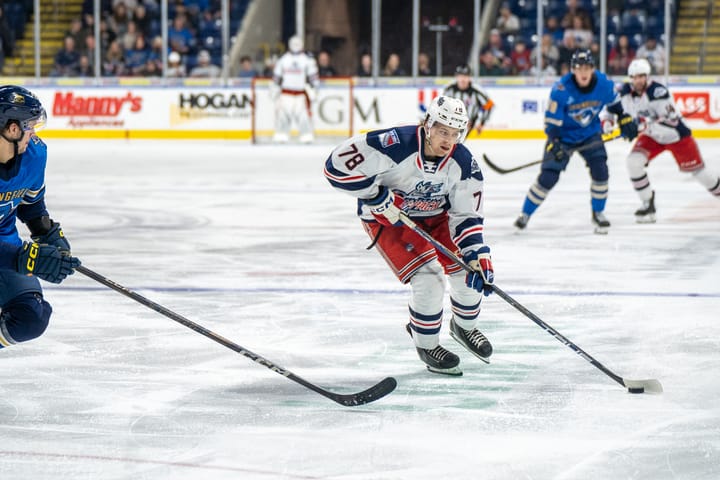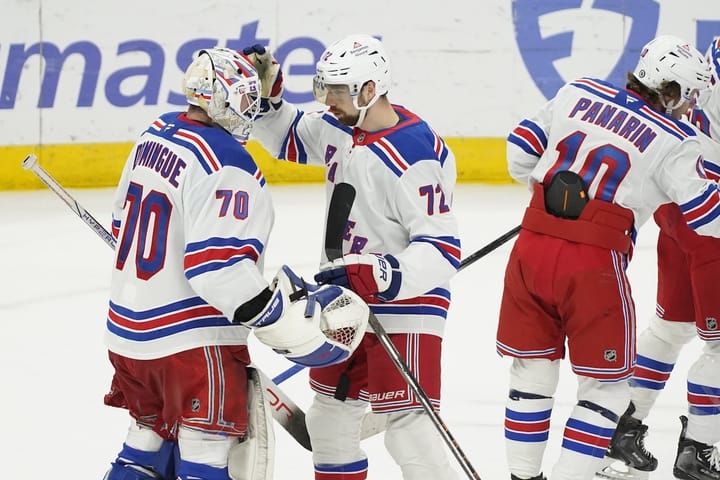What’s In a Number?
Why jersey numbers and the players that wear them are intertwined
Hockey is a fast game, played on a 200-foot sheet of ice as 10 players chase down a small piece of black rubber. It can be hard trying to figure out who’s who out there when half the team is wearing a white jersey and you’re far from the action.
Luckily, those players have two large digits stitched to the back of their jerseys to help us identify who’s doing what and how poorly they’re doing it.
Jersey numbers are so ubiquitous to all team sports, dating back to turn of the 20th century and the Cleveland Indians adding numerals to their jersey sleeves. It’s obviously evolved to the point of a jersey number becoming more than just a piece of fabric stitched onto another piece of fabric.
Jersey numbers — especially in hockey — have morphed into their own part of the narrative of the sport.
Goalies normally wear numbers in the 30s and 40s, or 0 and 1 (I dunno, goalies are weird). Defenders keep to the single digits and sometimes push into the teens, while wingers mostly sit in the 20s, and centers take whatever is left over.
Some players choose numbers with special meaning to them, like Jaromir Jagr famously selecting 68 in honor of his grandfather dying during the Prague Spring in 1968. Others turn an ordinatry number into something meaningful. Former Ranger Rick Nash wanted to wear 16 as in he did during his time in the OHL, but it was taken in Columbus so he decided to flip it into 61 and he and the number became synonymous during Nash’s career. Some have a very strange obsession with their birthdate and need it plastered on every aspect of their career (looking at you, Sidney Crosby).
A player’s number becomes part of their career and a part of the narrative of the organization. Can you imagine another Ranger wearing 30, 11, 35, or 2 today? Those last three numbers are retired for a reason, with the player and the number intrinsically linked forever and it’s a major factor in telling the story of the New York Rangers.
Now, as the Rangers head into a brand new generation built around a core of young talent, that story is going to be filled with new numbers that become calling cards for years to come.
One of those numbers is causing a bit of buzz around Rangerstown. Kaapo Kakko, the 18-year-old Finnish phenom selected second overall by New York in June, spent his entire career in the Finnish Liiga wearing No. 24, although he sometimes wore No. 34 while playing in international tournaments. There’s a problem, though, as Boo Nieves currently wears 24 and Kakko showed up to rookie camp wearing 45, causing much consternation among the populace.
Forty five is such an odd number for a forward. It doesn’t fit and it’s kind of clunky. It just doesn’t seem like a goal scorer’s number. It doesn’t have the strongest history, as it was most recently worn by backup goalie Magnus Hellberg, so this doesn’t really seem to fit a player like Kakko.
It appears though, that Kakko will get his crack at No. 24, with Boo reportedly switching to No. 15 for next season. For Kaapo, he has some big skates to fill as he looks to supplant former Rangers captain Ryan Callahan as the best player to wear that number.
As for the young Russian winger Vitali Kravtsov? He’s going to don the oddly cool 74, which was only worn once in Rangers history by Joel Bouchard in 2003-04. So when Kravtsov steps onto the MSG ice in October he already becomes the best 74 in New York Rangers history.
BREAKING: Boo Nieves wearing No. 15 on helmet at NYR informal skate. Apparently someone else will be wearing 24 at camp. (Told that Nieves approached trainers this morning and asked for change).
— Larry Brooks (@NYP_Brooksie) September 10, 2019
It may not seem like much but the number on a player’s back is almost as important to the numbers in his scoresheet. The next wave of numbers will get their chance to make history.




